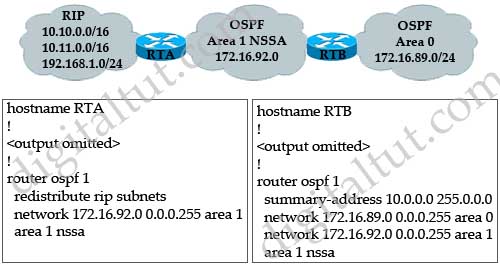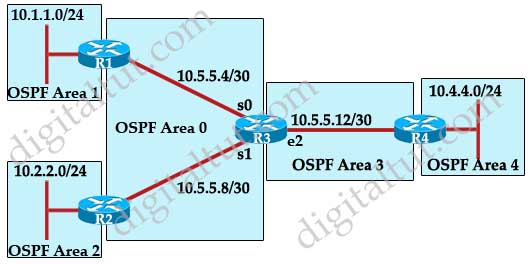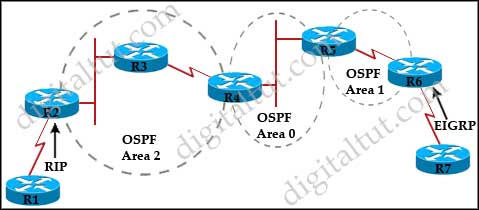OSPF Questions 10
Here you will find answers to OSPF Questions – Part 10
Question 1
Refer to the exhibit. Which statement is true?

A. RTA will redistribute the RIP routers into the NSSA as type 7 LSAs. RTB will translate the type 7 LSAs into type 5 LSAs and flood them throughout the OSPF backbone.
B. RTA will redistribute the RIP routers into the NSSA as type 7 LSAs. RTB will flood the type 7 LSAs throughout the backbone.
C. RTA will redistribute the RIP routers into the NSSA as type 5 LSAs. RTB will flood the type 5 LSAs throughout the backbone.
D. RTA will redistribute the RIP routers into the NSSA as type 5 LSAs. RTB will translate the type of 5 LSAs into type 7 LSAs and flood them throughout the OSPF backbone.
E. RTA will not redistribute the RIP routers into the NSSA.
Answer: A
Question 2
What is the sequence, from first to last, that OSPF will follow when choosing a router ID?
A. 1. the highest IP address on any active loopback interface;
2. The router-id command results;
3. The highest IP address of any active physical interface.
B. 1. the highest IP address on any active loopback interface;
2. The highest IP address of any active Physical interface;
3. The router-id command result.
C. 1. The highest IP address of any active Physical interface;
2. the highest IP address on any active loopback interface;
3. The router-id command results.
D. 1. The highest IP address of any active Physical interface;
2. The router-id command result;
3. The highest IP address of any active physical interface.
E. 1. The router-id command results;
2. The highest IP address of any active Physical interface;
3. The highest IP address of any active physical interface.
F. 1. the router-id command result;
2. the highest IP address on any active loopback interface;
3. the highest IP address of any active physical interface
Answer: F
Question 3
Refer to the network topology diagram shown in the exhibit. The routing table of R3 contains all the proper OSPF routes except the 10.4.4.0/24 OSPF route. Which show command on R3 will be the most useful to determine the cause of this problem and why?

A. Perform show ip ospf virtual-link to examine if the virtual link between R3 and R4 is configured and in the up state.
B. Perform show run to examine if area 3 is configured as a stubby area.
C. Perform show run to examine if area 3 is configured as a nssa area.
D. Perform show ip ospf neighbor to examine which router is elected as the DR on the e2 interface.
E. Perform show ip ospf database to examine the OSPF database entries.
Answer: A
Question 4
A network administrator recently redistributed RIP routes into an OSPF domain. However, the administrator wants to configure the network so that instead of 32 external type-5 LSAs flooding into the OSPF network, there is only one. What must the administrator do to accomplish this?

A. Configure summarization on R1 with area 1 range 172.16.32.0 255.255.224.0
B. Configure summarization on R1 with summary-address 172.16.32.0 255.255.224.0
C. Configure area 1 as a stub area with area 1 stub
D. Configure area 1 as a NSSA area with area 1 stub nssa
Answer: B
Question 5
Refer to the exhibit. Routers R2, R3, R4, and R5 have OSPF enabled. What should be configured on the routers in area 1 to ensure that all default summary routes and redistributed EIGRP routes will be forwarded from R6 to area 1, and only a default route for all other OSPF routes will be forwarded from R5 to area 1.

A. R5(config-router)# area 1 stub
R6(config-router)# area 1 stub
B. R5(config-router)# area 1 stub no-summary
R6(config-router)# area 1 stub
C. R5(config-router)# area 1 nssa
R6(config-router)# area 1 nssa
D. R5(config-router)# area 1 nssa no-summary
R6(config-router)# area 1 nssa
Answer: D


